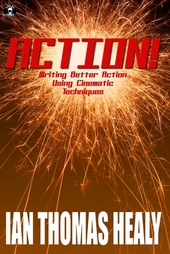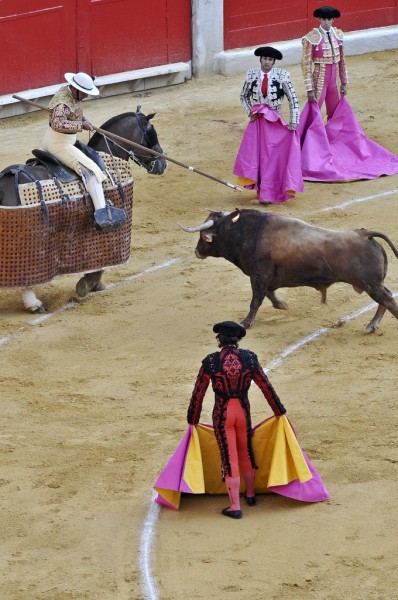I recently found a gem of a writing book. For my NaNoWriMo challenge, my current love/hate WIP, I decided I wanted to include more action scenes, pushing it more toward YA and more toward a true action book. OK. Action. That should be easy. Um. No.
 Until I read this book. Ian Thomas Healy breaks down action into manageable chunks in his book, Action! Writing Better Action Using Cinematic Techniques.
Until I read this book. Ian Thomas Healy breaks down action into manageable chunks in his book, Action! Writing Better Action Using Cinematic Techniques.
The title appealed to me right away because I do like action/thriller movies, and I recognize that writing action means you must fully evoke the visual, auditory and kinesthetic senses, like a movie would be able to do. Healy delivers.
Action Scenes = Violence
The first shocking thing to realize is that action means violence, says Healy. It’s not just movement, but conflict made concrete. Movement across a scene without a purpose is just the beat of a scene and action implies much more.
Healy breaks down action scenes into three levels: stunts, sequences and engagements.
1) On the simplest level, a STUNT is a single brief action. Carver pulls a gun and fires.
2) ENGAGEMENTS moves up a level by combining multiple stunts as a character moves across a setting. Now, you’re talking more choreography and relating the characters to the setting. Actions are physical, not mental, and thus, they require a setting. How the characters move across the setting while doing stunts is an Engagement. They end with the resolution of a plot point, or they transition into another Engagement, perhaps going from a chase to a fight.
3) A SEQUENCE is a combination of Engagements related in some way. Maybe they are about the same character, setting or conflict.

After listing what’s possible in this scene, I can start to map out the action. Often, this is just a mental map, but I can also fall back on a paper/pencil map when needed. Draw out the setting. Put an X where the characters are standing. Then Write #1, 2, 3 and so on for where they move to across the landscape to create an Engagement. Physically point–put your finger on the spot where the actions starts. Move your finger to the next spot where a stunt occurs. Sounds mechanical? Yes! But it works, and that’s the point. As I get better at this, maybe I’ll be able to do it all mentally. But for now, this is working great.
Finally, combining the Engagements into Sequences is simple.
There’s so much more in Healy’s book to recommend. Consider this provocative statement: “One of the most useful things you can do with an Engagement is use it to strengthen character relationships.”
If you’re writing or considering writing a book with lots of action, this is a great tutorial. On his website, Healy critiques some action scenes–interesting to see what he focuses on in the critiques!
One last thing. Yesterday, I was trying to write an action scene set in Mt. Rainier’s National Park and nothing was working. Then, I realized that was because I didn’t know the setting well enough! Of course, if action scenes move across the landscape, then I needed to know my landscape better. I spent the day studying Google Earth, watching You-Tube videos, scanning lists of flora/fauna, and hunting for autumn photos of the stunning vine maple. Before you can write about a physical space, you must know something about it!
Darcy, I love how you approach things, breaking them down into the parts and putting them back together so you can apply and then teach what you learned. It’s like magic!
I think a Mount Rainier retreat is in order, with exploration and lots of writing time included. Just think, you could actually BE your character in that setting. There’s a lovely old lodge there…
Let’s think about it!
Deb: I could go for a Mt. Rainier retreat! Let’s do it!
Darcy